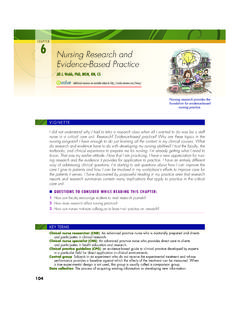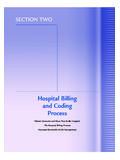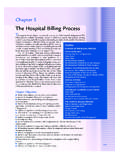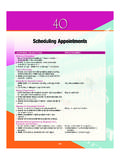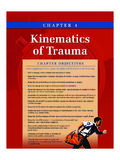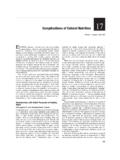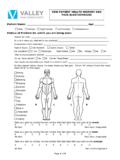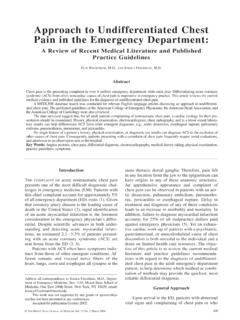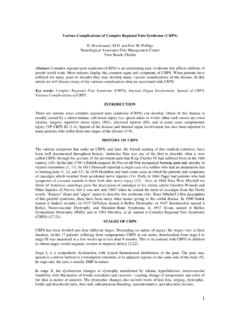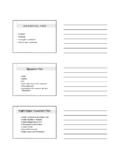Transcription of NURSING CARE PLAN 34-1 Patient with Acute Coronary …
1 Chapter 34 NURSING Management: Coronary Artery Disease and Acute Coronary Syndrome 833 Cardiovascular SystemNURSING CARE PLAN 34-1 Patient with Acute Coronary SyndromeNURSING DIAGNOSIS Acute pain related to myocardial ischemia as evidenced by severe chest pain and tightness, radiation of pain to the neck and armsPATIENT GOAL Reports relief of painOUTCOMES (NOC) pain Level Reported pain ____Measurement Scale1 Severe2 Substantial3 Moderate4 Mild5 NonePain Control Uses preventive measures ____ Uses analgesics appropriately ____ Reports uncontrolled symptoms to health care professional ____ Reports pain controlled ____Measurement Scale1 Never demonstrated2 Rarely demonstrated3 Sometimes demonstrated4 Often demonstrated5 Consistently demonstratedINTERVENTIONS (NIC) and RATIONALESC ardiac Care: Acute Evaluate chest pain ( , intensity, location, radiation, duration, and precipitating and al-leviating factors) in order to accurately evaluate, treat, and prevent further ischemia.
2 Monitor effectiveness of oxygen therapy to increase oxygenation of myocardial tissue and prevent further ischemia. Administer medications to relieve/prevent pain and ischemia to decrease anxiety and cardiac workload. Obtain 12-lead ECG during pain episode to help differentiate angina from extension of MI or pericarditis. Monitor cardiac rhythm and rate and trends in blood pressure and hemodynamic parame-ters ( , central venous pressure and pulmonary artery wedge pressure) to monitor for hypotension and bradycardia, which may lead to hypoperfusion. Systolic blood pressure ____ Diastolic blood pressure ____ Apical heart rate ____ Urinary output ____Measurement Scale1 Severely compromised2 Substantially compromised3 Moderately compromised 4 Mildly compromised5 Not compromised Peripheral edema ____ Dyspnea ____ Dysrhythmia ____Measurement Scale1 Severe2 Substantial3 Moderate4 Mild5 NoneINTERVENTIONS (NIC) and RATIONALESC ardiac Care Monitor vital signs frequently to determine baseline and ongoing changes.
3 Monitor for cardiac dysrhythmias, including disturbances of both rhythm and conduc-tion, to identify and treat signifi cant dysrhythmias. Monitor respiratory status for symptoms of heart failure to maintain appropriate levels of oxygenation and observe for signs of pulmonary edema. Monitor fl uid balance ( , intake/output, daily weight) to monitor renal perfusion and observe for fl uid retention. Arrange exercise and rest periods to avoid fatigue and decrease the oxygen demand on DIAGNOSIS Ineffective tissue perfusion (cardiac) related to myocardial injury and potential pulmonary congestion as evidenced by decrease in BP, dyspnea, dysrhythmias, peripheral edema, and oliguriaPATIENT GOAL Maintains stable signs of effective cardiac perfusionOUTCOMES (NOC)Cardiac Pump 8338/6/06 9:38:39 AM8/6/06 9:38:39 AM834 Section 7 Problems of Oxygenation: PerfusionCardiovascular SystemAdhering to a regular, individualized program of physical activ-ity that conditions the heart rather than overstresses the myocar-dium is important.
4 Most patients can be advised to walk briskly on a fl at surface at least 30 minutes a day, 5 or more days a is important to teach the Patient and the family in the proper use of nitroglycerin (see pp. 000). Nitroglycerin tablets or oint-ments may be used prophylactically before an emotionally stress-ful situation, sexual intercourse, or physical exertion ( , climb-ing a long fl ight of stairs).Counseling should be provided to assess the psychologic ad-justment of the Patient and the family to the diagnosis of CAD and the resulting angina. Many patients feel a threat to their identity and self-esteem and may be unable to fi ll their usual roles in soci-ety. These emotions are normal and real. NURSING Implementation Acute Coronary SyndromeAcute Intervention.
5 Priorities for NURSING interventions in the initial phase of ACS include pain assessment and relief, physio-logic monitoring, promotion of rest and comfort, alleviation of stress and anxiety, and understanding of the Patient s emotional NURSING CARE PLAN 34-1 cont dPatient with Acute Coronary Syndrome cont dNURSING DIAGNOSIS Anxiety related to perceived or actual threat of death, pain , possible lifestyle changes as evidenced by restlessness, agitation, and verbalization of concern over lifestyle changes and prognosis as substantiated by Patient s statement of What is going to happen when I die .. everyone relies on me Patient GOAL Reports decreased anxiety and increased sense of self-controlOUTCOMES (NOC)Anxiety Self-Control Monitors intensity of anxiety ____ Seeks information to reduce anxiety ____ Controls anxiety response ____ Uses relaxation techniques to reduce anxiety ____Measurement Scale1 Never demonstrated 2 Rarely demonstrated3 Sometimes demonstrated4 Often demonstrated5 Consistently demonstratedINTERVENTIONS (NIC) and RATIONALESA nxiety Reduction Observe for verbal and nonverbal signs of anxiety.
6 Identify when level of anxiety changes since anxiety increases the need for oxygen. Use a calm, reassuring approach so as not to increase Patient s anxiety. Instruct Patient in use of relaxation techniques ( , relaxation breathing, imagery) to enhance self-control. Encourage family to stay with Patient to provide comfort. Encourage verbalization of feelings, perceptions, and fears to decrease anxiety and stress. Provide factual information concerning diagnosis, treatment, and prognosis to decrease fear of the DIAGNOSIS Activity intolerance related to fatigue secondary to decreased cardiac output and poor lung and tissue perfusion as evidenced by fatigue with minimal activity, inability to care for self without dyspnea, and increased heart ratePATIENT GOAL Achieves a realistic program of activity that balances physical activity with energy-conserving activitiesOUTCOMES (NOC)
7 Energy Conservation Balances activity and rest ____ Recognizes energy limitations ____ Uses energy conservation techniques ____Measurement Scale1 Never demonstrated2 Rarely demonstrated3 Sometimes demonstrated4 Often demonstrated5 Consistently demonstratedActivity Tolerance Oxygen saturation with activity ____ Pulse rate with activity ____ Ease of breathing with activity ____Measurement Scale1 Severely compromised2 Substantially compromised3 Moderately compromised4 Mildly compromised5 Not compromisedINTERVENTIONS (NIC) and RATIONALESC ardiac Care Monitor Patient s response to antiarrhythmic medications since these medications will af-fect BP and pulse prior to activity. Arrange exercise and rest periods to avoid fatigue and to increase activity tolerance with-out rapidly increasing cardiac Management Assist Patient to understand energy conservation principles ( , the requirement for re-stricted activity) to conserve energy and promote healing.
8 Teach Patient and signifi cant other techniques of self-care that will minimize oxygen consumption ( , self-monitoring and pacing techniques for performance of activities of daily living) to promote independence as well as minimize O2 8348/6/06 9:38:40 AM8/6/06 9:38:40 AM Chapter 34 NURSING Management: Coronary Artery Disease and Acute Coronary Syndrome 835 Cardiovascular Systemand behavioral reactions. Research has shown that patients with increased anxiety levels have a greater risk for adverse outcomes such as recurrent ischemic events and Proper man-agement of these priorities decreases the oxygen needs of a com-promised myocardium and reduces the risk of complications. In addition, the nurse should institute measures to avoid the hazards of immobility while encouraging Nitroglycerin, morphine sulfate, and supplemental oxy-gen should be provided as needed to eliminate or reduce chest pain .
9 Ongoing evaluation and documentation of the effectiveness of the interventions is important. Once pain is relieved, the nurse may have to deal with denial in a Patient who interprets the ab-sence of pain as an absence of cardiac A Patient has continuous ECG monitoring while in the ED and intensive care unit and usually after transfer to a step-down or general unit. The nurse should be educated in ECG inter-pretation so that dysrhythmias causing further deterioration of the cardiovascular status can be identifi ed and treated. During the initial period after MI, ventricular fi brillation is the most common lethal dysrhythmia. In many patients, this dysrhythmia is preceded by premature ventricular contractions or ventricular tachycardia.
10 The nurse should also monitor the Patient for the presence of silent isch-emia by monitoring the S-T segment for shifts above or below the baseline of the ECG. Silent ischemia occurs without clinical symp-toms such as chest pain , but its presence places a Patient at higher risk for adverse outcomes and even If episodes of silent ischemia are seen on the monitor, the physician should be notifi ed. (See Chapter 36 for a complete discussion of ECG monitoring.)In addition to frequent vital signs, intake and output should be evaluated at least once a shift, and physical assessment should be carried out to detect deviations from the Patient s baseline param-eters. Included is an assessment of lung sounds and heart sounds and inspection for evidence of early HF ( , dyspnea, tachycar-dia, pulmonary congestion, distended neck veins).
